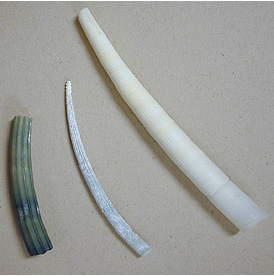
Photo: Ralph Body |
Literal meaning: Boat-footed or shovel-footed Common name: Tusk shell or tooth shell |
Shell:
The shell is open at both ends.

Photo: Ralph Body
Literal meaning: Boat-footed or shovel-footed
Common name: Tusk shell or tooth shell
Habitat: All specimens live in a marine environment away
from areas with strong waves.
Food: Small micro-organisms such as foraminiferans which live below the surface of the substrate.
(8-0-0-0-0-0-0-0-0-0-0-0-0)
Ref. Abbott, 1974 p 383
Abbott & Dance, 1982 p 386
Amer. Fish. Soc., 1988 p 5,50
Audubon, 1981 p 655
Dance, 1974 p 26
Keen, 1971 p 19,883
Lindner, 1978 p 120
Simon & Schuster, 1979 p 485
Tadash, 225
Vaught, 1989 p xi,142
Wagner & Abbott, 1977
Syn. Cirrhobranchiata H. M. D. de Blainville, 1825;
Lateribranchiata W. Clark, 1851;
Prosocephala H. G. Bronn, 1862;
Solenoconcha Lacaze-Duthiers, 1857
Ref. Habe, 1964 p 1